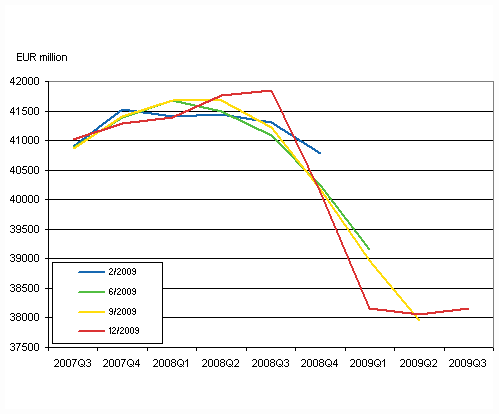On revisions in quarterly accounts
The data in all time series of quarterly accounts may become revised either because of revisions in the source data or changes in calculation methods. In addition to this, the figures of seasonally adjusted and trend series become revised almost without exception due to new observations even if no changes have taken place in the source data or calculation methods.
Quarterly accounts data for the third quarter of 2009 were released on 8 December 2009. The calculation methods remained unchanged but the seasonal adjustment method was altered by allowing outliers in the time series. In this release the data on the volume of GDP had become revised from the previous release of September 2009 as follows.
Changes from quarter twelve months back
These are calculated either from the original series or the series adjusted for working days.
- In the September release, the year-on-year changes in the volume of GDP calculated from the original series were: 2008Q4 -2.6%, 2009Q1 -7.5% and 2009Q2 -9.5%.
- In the December release, the year-on-year changes in the volume of GDP calculated from the original series were: 2008Q4 -2.6%, 2009Q1 -7.5% and 2009Q2 -9.2%.
Figure 1: Revision of original GDP volume series in quarterly national accounts publications

Thus the revisions of the year-on-year changes were minor so that only the figure on the second quarter of 2009 became revised slightly upwards.
Changes from the previous quarter
These are calculated from the seasonally adjusted time series.
- In the September release, the quarter-on-quarter changes in the volume of GDP calculated from the seasonally adjusted series were: 2008Q4 -2.5%, 2009Q1 -3.0% and 2009Q2 -2.6%.
- In the December release, the quarter-on-quarter changes in the volume of GDP calculated from the seasonally adjusted series were: 2008Q4 -4.1%, 2009Q1 -4.9% and 2009Q2 -0.3%.
Figure 2: Revision of seasonally adjusted GDP in quarterly national accounts publications 2008Q4-2009Q3

The calculated percentages of change from the previous quarter contain significant revisions, which can also be seen in the seasonally adjusted series of GDP in Figure 2. The revision of the seasonally adjusted time series in the December release was caused by the level shifts that were allowed for the last quarter of 2008 and the first quarter of 2009, which altered the picture of the economic situation. According to the seasonally adjusted time series modelled without the level shifts the economic downturn would have started in the second quarter of 2008 and would still continue strongly. The source data do not support either of these statements. When the level shift is used in seasonal adjustment the steepest decline of the economy coincides with the last quarter of 2008 and the first quarter of 2009, as can also be concluded from the source data. For further information about level shifts in seasonal adjustment, see separate methodological release at: http://tilastokeskus.fi/ajk/tiedotteet/2009/tiedote_019_2009-12-08_en.html
The level shifts apply to series on the volumes of the following: GDP at market prices, value added of the national economy at basic prices, secondary production, total industries, manufacturing (total), wood and paper industry, metal industry, other manufacturing, trade (total), imports (total), import of goods, import of services, total supply, exports (total), export of goods, export of services and total demand. Level shifts were also included in the respective series at current prices with the exception of the series on the wood and paper industry.
It should be borne in mind that irrespective of the level shifts that were now allowed, seasonal adjustment methods are highly sensitive to the latest observation so the time series will continue to be revised against new observations. Therefore, the monitoring of economic development should not rely on seasonally adjusted figures only. For this reason releases of quarterly accounts always also contain data on the year-on-year change of GDP calculated from series adjusted for working days.
Inquiries: Mr Pasi Koikkalainen, +358 9 1734 3332, Mr Samu Hakala, +358 9 1734 3756
Last updated 10.12.2009
Official Statistics of Finland (OSF):
Quarterly national accounts [e-publication].
ISSN=1797-9765. Helsinki: Statistics Finland [referred: 26.4.2025].
Access method: http://stat.fi/til/ntp/ntp_2009-12-09_uut_001_en.html

